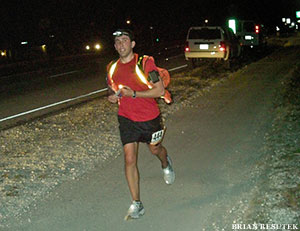
The doors clang outside my Miami hotel room at 3:30 a.m. as I make out the runner talk in the hallway. I slowly comprehend that this is quite likely the first of the 500 teams heading to the start line for Ragnar's 199 mile relay race from Miami to Key West. It wouldn't be fair to just call it an adventure race. It's two days and one night of constant grinding, adrenaline, sweat and burn. Racing in America is no longer just about pounding pavement and cutting times; it's about an experience. And overnight racing is one of the hottest racing experiences in the U.S. There's enough of a market to schedule 15 more of these events this year.
This race will begin as early as 5 a.m. for some teams, and bring about 5,000 runners to the southernmost point of the US. I'm running it for the first time. I shut my eyes, unaware that the next three hours of sleep will be of the best I get in the next 48 hours.
“At 150 feet, here is what a runner that is not wearing a vest or headlamp looks like,” the safety instructor informs our team while holding up a large poster board that is largely dark to illustrate his point in the pre-race safety briefing.
He switches to the poster board showing the properly illuminated runner, and the two distinct images resonate nicely in my mind along with the directions that it’s not a choice to wear these in the night time hours. I nod in agreement with my six newly formed team members, whom I’ve known for a grand total of two hours.
After some ordinary banter and meaningless stretching, we head back to the sea of white extended vans in the parking lot that would become our home until Key West. Our van (van No. 1) is neat inside and sports nothing but standard white paint on the exterior, an obvious sign of the race series' amateurism. Compared to the many innovative, colorful, and graphically brilliant vans of competing teams, we're clearly the team with noobs. Fortunately, three of my teammates are past participants, who do us first-timers a favor and slap our names and other G-Rated information on the van so we are not confused as a nondescript plumbing or cable repair van. Our transportation will run the first six legs of the race and then hand off to our second team of six runners in van No. 2 to begin their running legs with the process continuing until Key West. As dawn creeps on, we roll out.
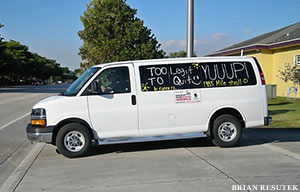
***
"Run, Drive, Sleep? Repeat."
While Tanner Bell may take credit for the slogan, he would be the first to point out that it was the lifelong dream of the father of friend, and co-founder Dan Hill, to run a 24+ hour relay race. While the concept of overnight racing did not begin in 2004 with their first Wasatch Back Relay in Utah, it is difficult to discount the growth of this adventure race without mentioning their Ragnar Series.
Constructed during their college days at Brigham Young, their vision is turning a sport of solitude -- running -- into a team event, allowing for equal satisfaction from novice through elite runner. Walk around, and the still young vision's spread is confirmed. I overhear two teammates conversing about the upcoming Boston Marathon, one talking about his preparation and the other providing confidence that he will hold a sub 10-minute mile pace. Then they pound fists for good luck with the rest of their teammates.
Getting out of Miami and "to the Keys" is not the only challenge for race organizers, but also a challenge for the relay runners, whose adrenaline is pumping and regardless of the event, will remain directionally challenged, especially when the going gets tougher.
The gun fires for the 1 p.m. start time, and our first runner takes off with other lead runners, a group that also includes a six-person "ultra" team featuring a future husband and wife decked out in bridal attire. Individuals of ultra teams will each run 35-40 miles of the course, running the same segments, but double the distance. The bride-to-be states that their ceremony at the end of the race will be small, but is what they wanted following their ultra race. I can't imagine what they have come up with for their honeymoon plans. Ironman, anyone?
We shout words of encouragement to our first runner, and then head back into our van. The 36 legs of the relay vary in length and difficulty, but course organizers try to think of the "ideal" race being comprised of 36, 10K races, but in adventure racing, it’s this variation, anticipated or unanticipated, that is part of the attraction. If you came for a chip-timed, closed course race with the traditional bagels, bananas, and a t-shirt at the end, you would be disappointed.
I am runner No. 2, so the first exchange is where my true race starts. Our van finds the designated parking area, and I quickly realize the value of not only having the knowledge of your current route, but also having drivers capable of getting to the exchange prior to the runner’s arrival. The temperature is in the high 70’s today and while waiting, I’m puzzled as to why there is a runner dripping sweat and just standing around looking ticked off. As volunteers offer up their cell phones, I realize that his team van has yet to arrive, leaving him dumbfounded and lonely upon completion of his first relay leg.
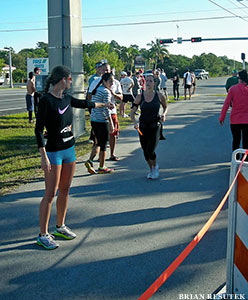
Ten minutes later, a van decorated with pirate paraphernalia and runners laughing stops along the road, an unofficial parking area. Their runner No. 2 jumps out and to takes the exchange bracelet. Volunteers offer assistance to the van regarding if they know how to get to the next exchange point; to which they say they need none. Not a soul among us believes them as we wave them good-bye.
The volunteer alerts me that my teammate is 200 yards out and I head into the relay corral. A minute later, the bracelet is slapped on my wrist and I’m off on leg two. A few quick turns finds me on a city sidewalk through Coconut Grove. While I’m running a race, to any casual observer, I most likely look like an average runner on any given day wearing a flashy orange bracelet. Unlike typical races, there is not a volunteer or police car stopping traffic to give me the right of way. If I miss the turn, no one is there to direct me back, and I risk costing my team time and frustration, something I just witnessed. My goal is to not screw up. By dumb luck and my nature to over-prepare, I actually consulted the route map prior to my leg. The provided course book is an extremely helpful and necessary guide for the runners and drivers to follow. Perhaps it’s the early energy, but I miss the right hand-turn side; however seeing the street sign triggers my mind to correctly turn right per the course book. Crisis averted and further confidence builds as I see another relay runner ahead. I make my way around the University of Miami to the next exchange to greet my teammates and receive my hi-fives, an appreciative sign of contribution and reminder of the team aspect of the race.
The team successfully makes its way through our first six legs as we meet our second van at the Miami Zoo. The first of the major exchanges, these areas are well thought out to accommodate the vast amount of vans and participants consolidating for the team exchange along with areas for medical, food, and any other pertinent race information needed. Our final runner flies down the zoo entrance to handoff to the lead runner of the second van. Inside our van, empty water and Gatorade bottles have become more prevalent along with a disarray of bags, shirts, and various undefined items that the nearing darkness will help cover until daylight. We drive into some rush-hour traffic on this Friday night, and we realize that the combination the fast members in van two and our responsibility to be at the next major exchange ahead of their final runner will allow, at best, minimal time for any rest or dinner.
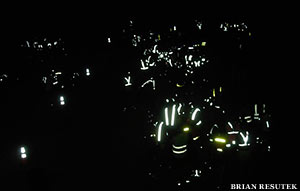
"There is no chance that this business can succeed outside of the state of Utah, it's too much of a family model, and unlikely to be successful anywhere else," recalls Tanner of the second place finish in the entrepreneurial contest. These were the words Dan and Tanner received from the judging panel after losing to the "Hot-dog guy" shortly after launching their initial overnight relay events. While each were putting their college degrees (Tanner in Information Systems, Dan in Economics) to work while concurrently operating their initial overnight races, six months post-college they each committed to their true passion and quit their jobs to concentrate solely on Ragnar. Their decision didn't open the flood gates to venture capital or private equity firms though.
Tanner recalls his first marketing decision in promoting Ragnar at a marathon expo in New Mexico.
"I knew I had enough money for either a rental car or a hotel room, but not both," Tanner recounted. "I chose the rental car from the flexibility standpoint, and was never so cold in my life sleeping in that parking lot."
***
With a leg under everyone's belts, there is an energy among all race participants as teams prepare for their night racing legs. All the stars are out, and the drop in temperature feels good against my face, a face that received too much Florida sun in leg one. I watch the tiny blinking dots out on the course slowly march towards the speedway while another group makes speculative bets as to which blinking light is their final runner. Our opportunity for a photo of a team handoff fails as our final runner screams into the exchange corral leaving the digital photo attempt seconds behind, and our lead runner takes off into the Florida darkness.
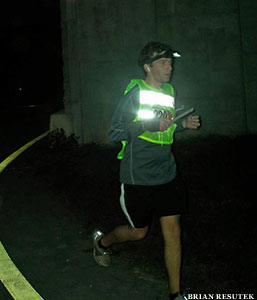
Sixty miles into the race, we have finally worked our way into Everglades National Park. It’s about 10:30 p.m., and I'm donning my runner's headlamp and required LED lights when I take the relay bracelet for the second time. The stars blanket the sky and the full moon yields incredible secondary light as I make my way down the dirt road. I pass a runner, and realize that I’m essentially running by myself through the Everglades at night. Despite being on course, I haven't a clue logistically where I am, but my pace kicks up as I take in the experience that vastly differs from morning training runs down Peachtree Street in Atlanta. An illuminated sign alerts me to stay straight on the rocky service road as I spot multiple blinking lights ahead that I will "kill" in the coming minutes. Yes, I learned that in running relay vernacular, a kill represents an individual passed while a suicide is the term used when you are passed. During this segment, I'll tally 19 kills against zero suicides to later add onto our van door. A half mile from my leg finish, I find myself again alone on the road and switch off the head lamp to run under the power of the full moon; I think I’ve found a new type of running high.
After my teammates complete their night legs, we handoff to our partner van around 2 a.m. and I find a pillow and immediately pass out for two hours. The combination of short race legs and a our fast members in van No. 2 results in a short nap and I’m awake again staring out the window as full moon disappears into the Keys; time for my final race leg.
I'm almost late for the exchange as our lead runner (and main driver), running on zero sleep, completes his fastest leg yet. My leg is a 9.5-mile trek that will encompass all of the 7-mile Bridge and leads us out of the city of Marathon, of all places. Sunrise is set for 7:08 a.m., and at 6:58 a.m., we make the exchange.
I've compiled quite a log in endurance training of all types in preparation for past Ironman races and endless runs to achieve marathon qualification, but running on two hours sleep after two earlier 10k's, all while recovering in a van, was brand new brick workout for me.

True to my poor running discipline, I set a fast pace with the excitement of the sunrise over the bridge. It's nearly two miles until I hit the bridge, but once on it, even the pelicans below appear to pause to soak in the event. I take multiple peeks at the sunrise but remain cognizant that drifting too far right of the cones will likely result in this being my last sunrise. Half-way over the bridge, my legs are shot and I’ve drifted slightly off my desired pace. Creating small goals, I push on to finish strong wondering when landfall will ever be on this leg. I pass an ultra runner who is finishing about a 40-mile “training run” for his 100-mile sole endeavor later this year. He appears well seasoned in these events, yet also marvels at this unique experience that we are both fortunate enough to witness.
Exhausted from a combination of factors, I find my teammate and send him on his final leg. The remaining handoffs go clean, and shortly after 1 p.m., our final runner flashes around the final curve in Key West and we all join him for the final celebration to finish line.
In slightly more than 24 hours, our team of 12 completes the journey. The ultimate winners finished in 21 hours, and the remaining teams cascaded into Key West as the sun set. While team and individual goals are likely different for the finishers, everyone appears to have the same thought post race: when’s the next one? The slogan suddenly makes sense, as I would repeat, but please, give me some sleep first.
Popular Stories On ThePostGame:
-- Jeremy Lin TV Graphic Raises Concerns
-- White Star, Black School: Landon Clement Is The Face Of Upstart North Carolina Central
-- End Game: Brain Trauma And The Future Of Youth Football In America
-- Can Sport Specialization Cause Youth Injuries?







